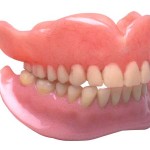 Preprosthetic surgery or preprosthetic mouth preparation is a surgery preparation done before placement of any new prosthesis (dentures or bridges). It is done to modify your denture supporting tissues so that your dentures can be worn comfortably.
Preprosthetic surgery or preprosthetic mouth preparation is a surgery preparation done before placement of any new prosthesis (dentures or bridges). It is done to modify your denture supporting tissues so that your dentures can be worn comfortably.
Before the surgery, a thorough history and clinical examination will be carried out to evaluate the condition of your denture supporting tissue.
Below are some common hard tissue conditions which require preprosthetic surgery:
 (i) Unerupted teeth and embedded roots
If a root or an unerupted tooth is embedded deeply inside your bone, it may be unnecessary to remove it to preserve the alveolar bone. However, if the tooth or root is embedded partly in your bone or is in contact with the overlying soft tissue,it is best to remove it to prevent pain produced by pressure from denture.
(ii) Sharp bony ridges
Sharp bony ridges often occur in the lower anterior region. Denture (large amount of forces can be generated while eating with your dentures) which impinges the sharp bony ridges can cause you some amount of pain. Recontouring of the alveolar ridge which is also known as alveoloplasty can be done to smoothen the sharp bony ridge and provide the best contour to support your prosthesis. Alveoloplasty surgery is done by creating a flap and your dental practitioner will recontour the sharp bone ridges using a bone bur or other instruments.
(iii) Enlarged tuberosities
Tuberosities are bony protrusions behind your last molar in the upper jaw. It may interfere with the insertion of denture if a tuberosity is too large in size. An enlarged tubersity can also interfere with the seal of your denture. A seal is required to ensure that your denture seats in a proper place.
 Reduction of hyperplastic tuberosity:
 1. The surgery will be carried out under local anesthesia. Hence, there should be minimal discomfort during the surgical procedure.
2. An elliptical incision will be made down the bone and excess soft tissue/bone will be removed.
3. Sutures will be placed to stitch the gums together.
(iv) Torus
Torus are bony prominence which may be present in the upper jaw (torus palatinus) or lower jaw (torus mandibularis) They can cause discomfort, denture instability and interfere with the seal of denture. You may not be aware of the presence of torus as they have been present for a very long time. Removal of tori is indicated if they are too large in size and interfere with your denture stability. During the removal of torus, incisons will be made and flaps will be raised. The oral surgeon will remove/trim the bony prominence by using a bone bur.
Here are some post operative instructions that you should follow after undergoing any preprosthetic surgery.
1. Avoid eating/chewing at the surgical site.
 2. Reduce or avoid smoking for the first few days.
3. Playing/touching the surgical site with your tongue.
4. Maintain your oral hygiene by brushing well (use a soft toothbrush and do not brush at the surgical site)
5. Rinse your mouth with warm salt water or Chlorhexidine mouthwash.
6. Report to your dental practitioner if you are having extensive bleeding, pain or swelling.